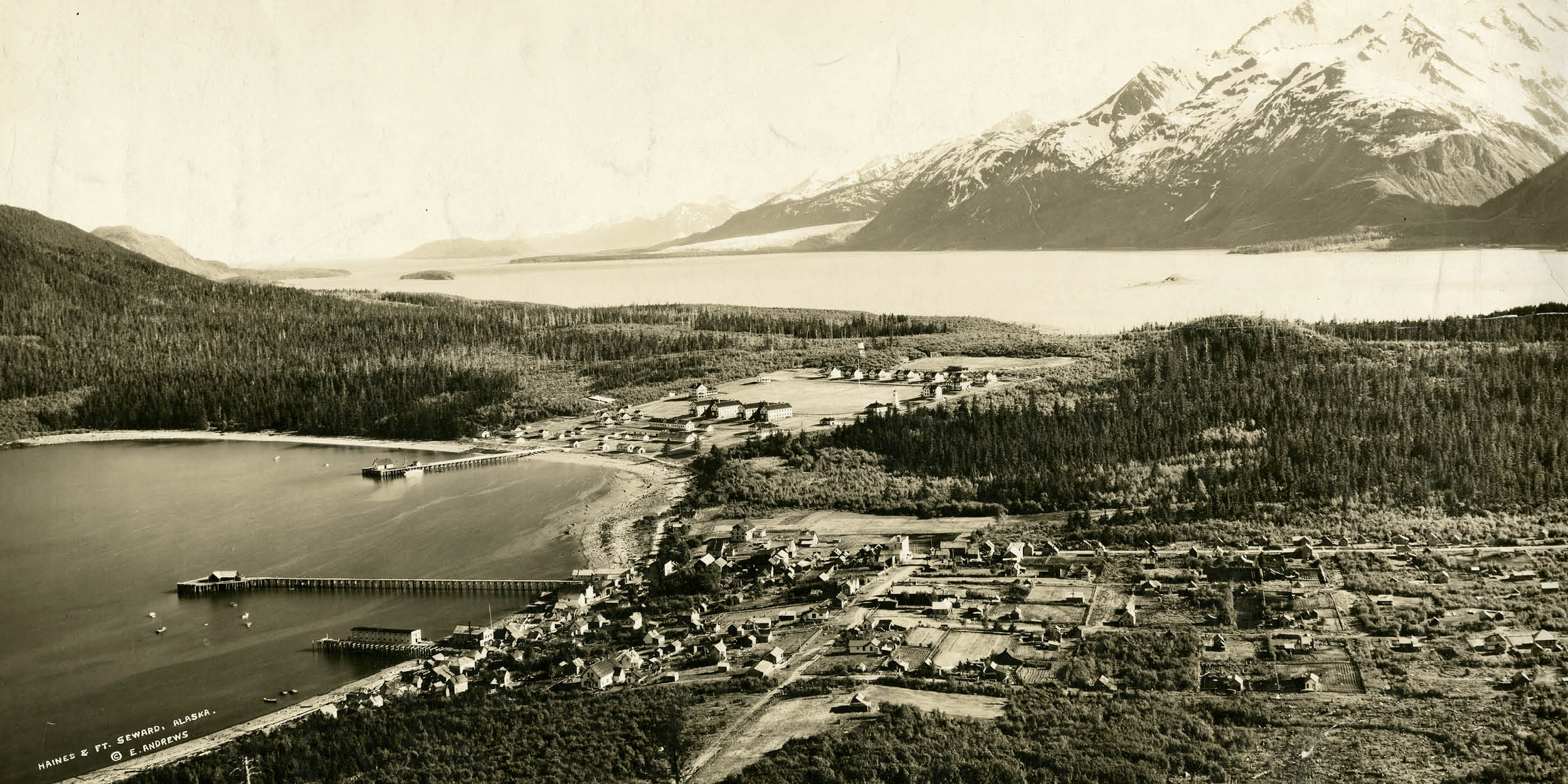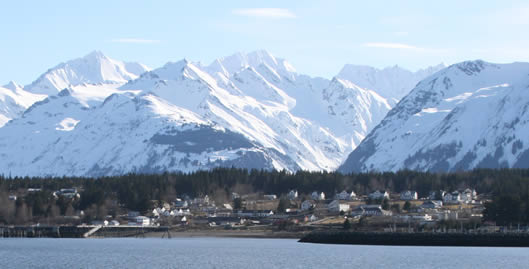
A classic view of Fort Seward, Haines, Alaska taken from picture point.
“The History of Haines is rich and diverse; a tapestry of events that over time shaped and formed the community. Since its establishment in 1881, Haines has grown, at times contracting and then expanding and above all, reflecting the many events that affected the town’s life. The establishment of the Presbyterian mission, discovery of gold at Porcupine in 1898, development of the salmon canneries, and construction of Fort William H. Seward in 1903 influenced the developing community.

Haines Alaska seen from on top of Mount Ripinsky, 2010. Photo courtesy of Brian Martin.
Tightly interwoven throughout this complex chain of events are individuals who formed the backbone and structure of Haines: Tlingit Natives, white explorers, Presbyterian missionaries, gold miners, adventurers, farmers, entrepreneurs, carpenters, laborers, merchants, soldiers, families, and dream-seekers, each interacting against the backdrop of history. Many came in response to the excitement and promises generated by what appeared to be unlimited opportunities. Others were born to the events. All became inextricably a part of Haines’ rich past.” excerpt from City of Haines: Survey of Historic Structures.
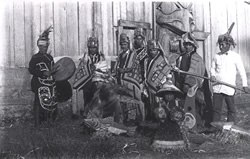
No one knows just when the earliest people came to live in the Chilkat Valley. We do know that one group of Tlingit people, the Chilkats, were already well established long before the earliest recorded white men visited the area some two hundred years ago. This powerful tribe of people fished, hunted, and preserved a variety of foods for themselves and for trading purposes. They had a flourishing trade business with the Indian tribes east and north of the surrounding mountain ranges, as well as a highly developed social system.
For centuries, indigenous people had lived in small villages along the nearby Chilkat and Chilkoot Rivers. Traveling the deep valleys at the head of the fjord, Tlingit Indians living on the coast traded furs, salmon, and eulachon oil (rendered from smelt-like fish) for copper, moose hides, and other commodities obtained from Athabascan people of the interior. Indeed, Haines’ first “gold” was fish!
Shortly after the purchase of Alaska from the Russians (in 1867), the Chilkat chiefs heard of missionaries and teachers in Sitka and Wrangell. Not wanting to be outdone, they petitioned the Presbyterian Church for the same assistance. The church replied that, while they could not send five missionaries (one to each native settlement in the area), if the chiefs could agree on one place for them to station a person to serve all five villages, a preacher and a teacher would be sent to them.
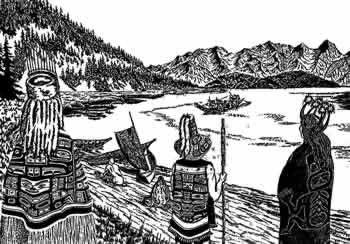
Tlingits in full regalia in front of a clan house.
In 1879 the chiefs sent a message that they had agreed upon a place, and Dr. Sheldon Jackson sent S. Hall Young and John Muir to meet with them. Travelling in a sea-going “war” canoe with four Indian guides and paddlers, they met at Yendestucky, a meeting village near today’s airport. Dei-Shu meaning “End of the Trail”, a place which belonged to all the people and had no permanent dwellings, had been chosen.
As there was to be a mission, a trader thought that there should also be a trading post, and in 1880, after he had set up across the trail from the mission area, the Presbyterian Church hired his wife, a Tsimshian woman who had had some schooling, to begin teaching. Her books never came and she didn’t get very far teaching some 50 children with two books, but at least it was a start.
How did Haines get its name?
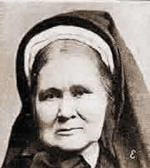
Francina E. Haines
Francina E. Wilder, born in Paris, France on Valentine’s Day 1819, was the first Protestant missionary to Athens, Greece. She married Richard Townly Haines, a director for the American Bible Society and founder of the Westminster Presbyterian Church in Elizabeth, New Jersey. According to a 1937 letter by one of their 12 daughters, Frances Stoddard Haines, both Mr. and Mrs. Haines authored several religious works.
In 1881, a Presbyterian mission was established on the neck of the peninsula dividing the mouth of the Chilkat River from Lynn Canal. Upon the arrival of the Reverend Eugene and Caroline Willard, both school and church services of the Chilkat Mission were held in a shed. Sheldon Jackson from Sitka and head of the Presbyterian Missions throughout Southeast Alaska, personally borrowed money for a Chilkat Mission building. This was repaid through the efforts of the Presbyterian Church’s Women’s Executive Society of Home Missions, an organization which helped form new missionary sites in many states. Mrs. Haines was the secretary of the Society at this time, so the mission was renamed Haines Mission after her. Later, when the city was incorporated, it was also named Haines.
A Historical Chronology
- 1774
- Spaniards explored the Northwest coast from Olympia, Washington, to the head of Lynn Canal. They published no charts, however. Captain George Vancouver met them in the Alexander Archipelago in 1793.
- 1794
- While exploring the southern stretches of North America’s longest fjord for England, Vancouver named Lynn Canal for his home town of King’s Lynn. Under the command of Joseph Whidby, several of his men traveled to the head of Lynn Canal, entering both the Chilkat and Chilkoot Inlets. Vancouver was soon followed by Russians, English, Spaniards, and Americans, all of them entering into a brisk trade with the skillful Chilkat and Chilkoot Tlingits. The continent’s deepest inland waterway, Lynn Canal would ultimately serve generations of white people as an important juncture between marine and land routes of the north, just as it had served the Tlingits since ancient times.
- 1869
- Returning to observe an eclipse of the sun, which according to early maps of the area, could easily be seen from Klukwan, Davidson was joined by William Seward (the man responsible for the purchase of Alaska from the Russians). As he was not traveling in any official capacity, Seward could be considered the first tourist to visit the Haines area.
- 1878
- When convinced the men would not interfere with their fur trade, the Chilkats guided a party of miners through their territory to the interior. Journeying up and down the Yukon and Pelly Rivers from Fort Selkirk, the miners found indications of gold.
- 1879
- Missionary S. Hall Young and his friend John Muir, in the company of Tlingits from Sitka, traveled to Yendustucky, five miles up the Chilkat River from present-day Haines. They were sent by Sheldon Jackson, in charge of Alaska’s Presbyterian Missions, to discuss the location for a mission with Chilkat and Chilkoot Chiefs. As their canoe approached, villagers came to the riverbank and fired shots over their head, alarming Young and Muir. The Sitka Tlingits told them not to worry: they were being greeted, not fired at! Upon reaching shore, the canoe was hoisted — men and all — and carried to the clan house. There they were completely ignored for a short time; according to Tlingit custom, it was polite for travelers to be given time to collect their thoughts after a long journey. “…[B]efore Shathitch [also known as Kohklux] left, he and Donawok and Shundoo-oo, the chief and Iht (shaman) of Chilkoot, walked with me across the neck of the peninsula to a harbour on the east side.” S. Hall Young, Hall Young of Alaska. At Deishu (“end of the trail”) they decided on the site for the new mission.
- 1880
- A second party of miners was guided over the Tlingit trade route. George Dickinson opened a Northwest Trading Company post next to the site that had been chosen for the new Presbyterian mission. After arbitrating a disagreement between Chilkats and Chilkoots in August, the navy built a schoolhouse by the trading post and the Tlingits began building houses on each side.
- 1881
-
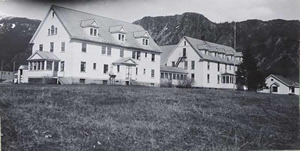
Haines House probably in the 1920s or 30s.July 18th, Dr. Sheldon Jackson arrived with Rev. Eugene Willard and his teacher-wife, The Willards soon realized that children had to come so far from various villages that, especially in winter, it would be more practical if there were a boarding school. The log building for the purpose was by far the largest in the entire area. This was the place Sol Ripinsky came to teach in 1885. It was the beginning of the town of Haines, which took its name from Mrs. F.E. Haines, a member of the Board of National Missions. A larger boarding house was constructed ten years later after a fire destroyed the first one. That building served as a boarding school, then as a hospital, and still later as an orphanage known as Haines House. Eventually, it became a boarding place for students from communities with no schools, and was active until 1960 when regulations imposed by the newly-formed State of Alaska were to expensive to comply with and the operation closed. The present Presbyterian Church was built on the foundation of Haines House; the Museum is on the northeast corner of the original Mission site.
- 1883
- By now more than two hundred prospectors had crossed over the Chilkoot Pass to the interior. The Chilkats retained control of the route, charging a fee to carry goods across the pass. Honoring Mrs. F.E. Haines, Secretary of the Women’s Executive Committee for Home Missions of the Presbyterian Church, the name of Chilkat Mission was changed to Haines Mission.
- 1894
- Jack Dalton, who had been employed at Chilkat Cannery, began packing over the Chilkat trade route and built trading posts at Dalton Cache (present US/Canada Border), Dalton Post (100 miles northwest of Haines), and Champagne (on the Alaska Highway near Whitehorse). From childhood memories, long-time resident Elisabeth Hakkinen recalls that “he [Jack Dalton] was a dapper, well-dressed ‘ladies man’ who came to dinner at our house.” Today’s Haines Highway follows fairly closely the Chilkat Pass Route which was once known as the Dalton Trail.
- 1898
- Prospector Charles Cahoon noted that in January of 1898, Haines consisted of “the Presbyterian Mission building, a small store, and a few Indian huts on the beach.” Pyramid Harbor Cannery was the largest cannery in the world at the time. A post office opened there in May and operated until October of 1900.
- In October three partners discovered gold in Porcupine Creek, a tributary of the Klehini River some 35 miles upstream from Pyramid Harbor. After finding approximately $1,000 worth of gold in ten days, S.W. Mix, Ed Fenlay, and Perry Wiley staked claims and another rush was on. Porcupine, which had been a n overnight stop along the Dalton Trail (whenever the conditions of the rivers and streams dictated that the trail should remain on that side of the Klehini River) soon became a thriving gold-mining community in its own right. By now, the stage had been set and the town of Haines began to grow. The “northern frontier” had become accessible–though perhaps not ready–for settlement, business, and development.
- 1903
- Fort William H. Seward – Built in 1903, partially occupied in 1904 and fully garrisoned in 1905. The commission of Fort Seward brought a population influx to Haines. Although the fort went through various names, it remained in operation until 1946, after which it was declared surplus and sold to civilians in 1947.
- 1906
- Eldred Rock Lighthouse, an isolated light station located on an island 24 miles south of Haines, was lit on June 1st.
- 1910
- Haines became a legal entity, when on January 6 every eligible voter went to the polls. By a vote of 72 to 19 they chose to become an incorporated city for the purposes of maintaining order and improving the school system.
- 1913
- Haines finally won its town site, after much litigation, from Solomon Ripinsky, who had claimed the land as a homestead.
- 1917
- Haines Packing Company cannery was built and began operation. Haines’ oldest business is still buying salmon, although the cannery itself has not operated for many years.
- 1943
- Haines Cut-Off Highway was built to connect with the Alcan.
- 1946
- Fort William H. Seward (renamed Chilkoot Barracks in 1922) is declared surplus and sold to army veterans who established homes and businesses.
- 1948
- Steve Homer, one of the above veterans, started the first Haines-Skagway-Juneau ferry system with the landing-craft “Chilkoot”.
- 1951
- Territory of Alaska purchased the “Chilkoot” from Homer – he ran it for them the first year. This was the beginnings of the Alaska Marine Highway System (although it was not officially established until 1963) that now services all of Southeast Alaska, the Gulf of Alaska, into Prince William Sound, the Aleutians and makes regular runs to Bellingham, Washington.
- 1953
- The Army Fuel Pipeline and Tank Farm were built. The pipeline ran from the Haines Tank Farm through Canada to Fairbanks. It ceased operation in 1972.
- 1968
- The Haines Borough was formed as the only Third Class Borough in the State.
- 1970
- Port Chilkoot officially became an integral part of the City of Haines.
- 1972
- The Post (Port Chilkoot, Fort William Seward) was designated as a National Historic Site and again became Fort William H. Seward.
- 1976
- The site for the new Sheldon Museum and Cultural Center was dedicated July 3rd as part of the Haines’ bicentennial celebration. The previous year the General Assembly of the United Presbyterian Church donated the land — the corner of the original mission to the Chilkat people. The building was dedicated in 1980.
- 1983
- Governor Jay Hammond, establishes the 48,000 acre Chilkat Bald Eagle Preserve, and the adjacent Haines State Forest Resource Management Area.
- 1986
- Ground breaking for the American Bald Eagle Foundation Center.
- 1990
- Walt Disney backs production of “White Fang” in the valley. The film became a 1991 box office hit.
- 1995
- First annual Bald Eagle Festival held in November. Festivals are still held each year at the same time and attract many visitors.
- 2002
- The City of Haines and the Haines Borough incorporated on October 17. The corporate boundaries of the Haines Borough are identical to those of the dissolved third class Haines Borough.
- 2010
- Haines celebrated its 100th Anniversary with a party on Main Street.
Present Day Haines
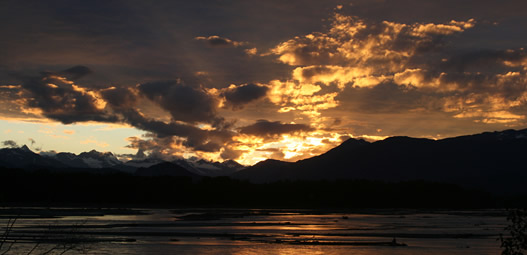
A beautiful sunset on the Haines Highway looking toward the Canadian border.
Nowhere else does the Alaska of your dreams come alive like it does in Haines! Here you’ll find a perfectly distilled sampling of Alaska’s history, scenic beauty, arts and culture, wildlife, and lifestyles.
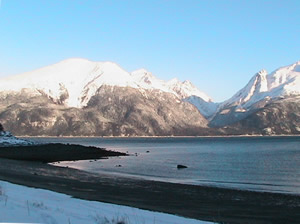
A scene driving a long Lutak Road.
This town of 2300 year-round residents, on the pristine shores of America’s longest fjord, is surrounded by glacier-covered mountains rising from the sea and numerous lakes and rivers teaming with fish and wildlife. Thousands of majestic bald eagles gather every fall in the welcoming embrace of the nearby Chilkat Bald Eagle Preserve. Renowned as an artist’s haven, Haines’ galleries and shops offer exceptional artwork in traditional native and contemporary styles.
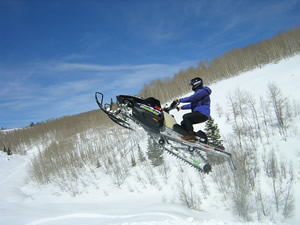
Snowmachining is popular around Haines, especially in the pass.
Outdoor enthusiasts will find unlimited opportunities for recreation, from biking, hiking and skiing to a variety of excursions on local rivers and lakes. Charter boats offer sight-seeing and sport-fishing for salmon and halibut. For a day or a week, winter or summer, whatever your interest in Alaska, you’ll find it in Haines.
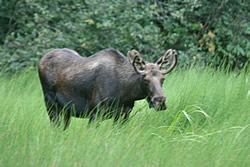 A young bull moose in velvet, grazing in a feild up the Kelsa Road. |
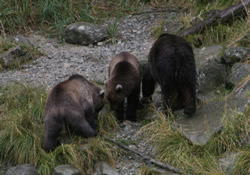 A sow and her cubs along the Chilkoot River. |
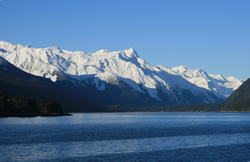 Mountain scenery scene from Mudbay Road. |
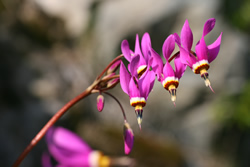 In late May sandy meadows along the Chilkat River bloom with shooting stars. |
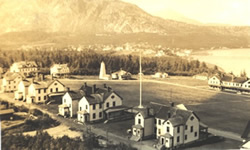
Fort William H. Seward, 1925.
Established in 1902, built in 1903 and garrisoned in 1904, Fort William H. Seward was the first permanent army post in Alaska, serving as the only military post for some 20 years. At the close of WWII it was decommissioned and sold as army surplus to a group of veterans. It is currently a unique arts and culture district.
Soon to celebrate its 110th anniversary, the Fort is a reminder of a grand time in U.S. military history, a time when nothing was impossible.
Blythe Carter, 2008
Recommended Reading
For more information on Haines and its people, we recommend the following books most available for order online at the Museum Store:
- Haines: The First Century (2009 edition) by Elisabeth S. Hakkinen
- A Personal Look at the Sheldon Museum & Cultural Center by Elisabeth S. Hakkinen
- More Than Gold: Nuggets of Haines History by Cynthia Jones (out of print)
- If You Live Here I’d Know Your Name by Heather Lende
- The Golden Circle by Bob Adkins
- Panhandle Pilot by Bob Adkins
- Haines for All Seasons by Kathleen Menke
- Alaska/Yukon/Arctic Light by Kathleen Menke
Bibliography:
Hakkinen, Elisabeth Sheldon. Haines: The First Century, 2009
Jones, Cynthia. More Than Gold: Nuggets of Haines History, 1999
Hakkinen, Elisabeth Sheldon. Haines History: People, Places and Events
Hakkinen, Elisabeth Sheldon. A Personal Look at the Sheldon Museum & Cultural Center, 1983
City of Haines, City of Haines: Survey of Historic Structures, 1983

